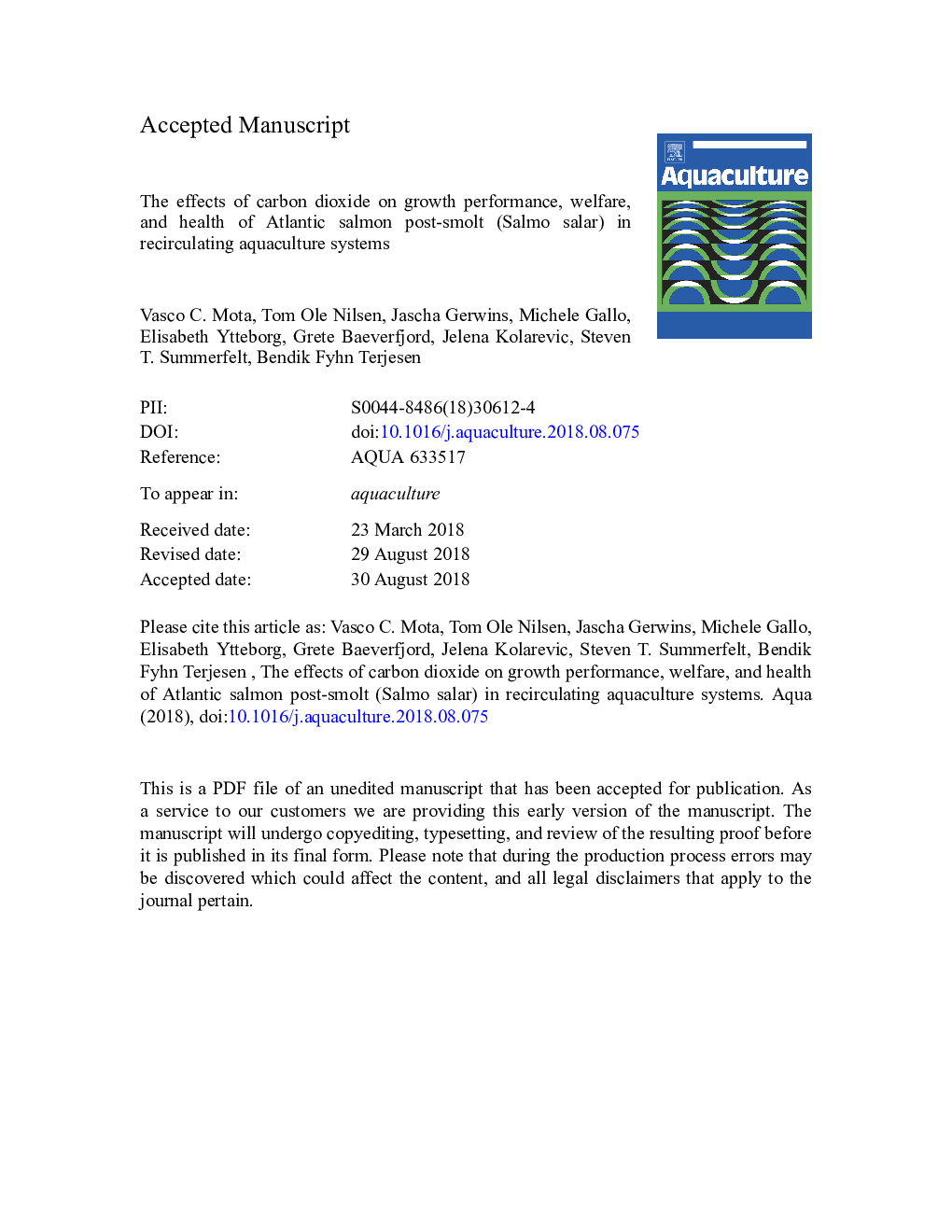| کد مقاله | کد نشریه | سال انتشار | مقاله انگلیسی | نسخه تمام متن |
|---|---|---|---|---|
| 11031950 | 1645731 | 2019 | 39 صفحه PDF | دانلود رایگان |
عنوان انگلیسی مقاله ISI
The effects of carbon dioxide on growth performance, welfare, and health of Atlantic salmon post-smolt (Salmo salar) in recirculating aquaculture systems
دانلود مقاله + سفارش ترجمه
دانلود مقاله ISI انگلیسی
رایگان برای ایرانیان
کلمات کلیدی
موضوعات مرتبط
علوم زیستی و بیوفناوری
علوم کشاورزی و بیولوژیک
علوم آبزیان
پیش نمایش صفحه اول مقاله

چکیده انگلیسی
High carbon dioxide (CO2) concentrations negatively impact fish, which makes data on its tolerance especially relevant for production systems that can accumulate CO2 such as recirculating aquaculture system (RAS). The current study evaluates the effect of CO2 on the growth performance, welfare, and health of Atlantic salmon post-smolts in RAS. This study consisted of two phases. The first was a CO2 exposure phase, where eighteen tanks were used with six treatments in triplicate: 5, 12, 19, 26, 33 and 40â¯mg/L of CO2 during 12â¯weeks in a 12â¯ppt salinity RAS (hereafter RAS phase). In the second phase, PIT-tagged fish were transferred to a 34â¯ppt salinity single flow-through tank at CO2â¯<â¯5â¯mg/L (hereafter seawater phase) for an additional 6-week experimental period mimicking a seawater phase. Overall, mortality of fish exposed to CO2 was low and not related to treatments. The mean final body weight was significantly higher in the 5â¯mg/L treatment compared to CO2 treatments â¥12â¯mg/L at the end of RAS phase and to CO2 treatments â¥33â¯mg/L at the end of seawater phase. Moreover, regressions showed that growth significantly decreased linearly with increasing CO2 in the water. Eye cataracts and visible external damage on skin, operculum, and fins were inexistent and similar among CO2 treatments. Kidneys showed no signs of mineral deposits in any of the structures of the tissue. However, skin analysis showed that fish exposed to high CO2 concentrations had a significantly thinner dermis layer (both at the end of RAS and seawater phase) and a significantly thinner epidermis layer and lower mucus cells count (at the end of seawater phase). In conclusion, Atlantic salmon post-smolts cultured in brackish water RAS showed a maximum growth performance at CO2 concentrations below 12â¯mg/L. Except skin, no major effects of health and welfare were observed, including cataracts and nephrocalcinosis. Further studies should evaluate the molecular and physiological responses to both short-term and long-term carbon dioxide exposure.
ناشر
Database: Elsevier - ScienceDirect (ساینس دایرکت)
Journal: Aquaculture - Volume 498, 1 January 2019, Pages 578-586
Journal: Aquaculture - Volume 498, 1 January 2019, Pages 578-586
نویسندگان
Vasco C. Mota, Tom Ole Nilsen, Jascha Gerwins, Michele Gallo, Elisabeth Ytteborg, Grete Baeverfjord, Jelena Kolarevic, Steven T. Summerfelt, Bendik Fyhn Terjesen,